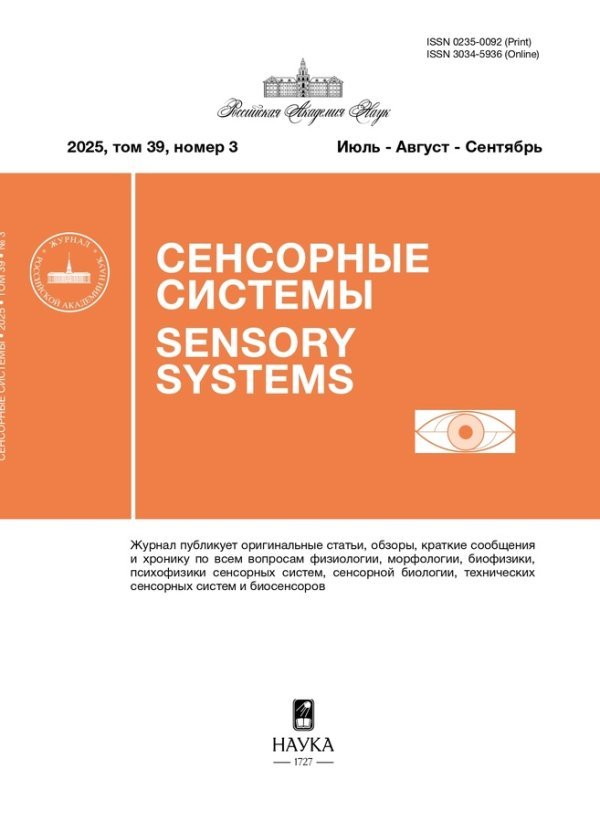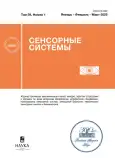The role of the envelope in the discrimination of rippled spectra by listeners with different auditory sensitivity
- Authors: Nechaev D.I.1, Milekhina O.N.1, Tomozova M.S.1, Supin A.Y.1
-
Affiliations:
- Institute of Ecology and Evolution of the Russian Academy of Sciences
- Issue: Vol 39, No 1 (2025)
- Pages: 14-26
- Section: СЛУХОВАЯ СИСТЕМА
- URL: https://modernonco.orscience.ru/0235-0092/article/view/682129
- DOI: https://doi.org/10.31857/S0235009225010025
- EDN: https://elibrary.ru/UUXMZG
- ID: 682129
Cite item
Abstract
A sound signal with a rippled spectrum exhibits envelope periodicity, which is absent in signals with a continuous spectrum. The study investigated the role of the signal envelope in discriminating signals with rippled spectra. The test signal was noise with a rippled spectrum and a spectral bandwidth of 2 octaves. Noise with a continuous spectrum was used as a reference signal. The experiments involved listeners with different levels of auditory sensitivity. To assess the ability to distinguish the density of rippled spectrum, a phase-reversal test was applied. Discrimination thresholds for spectral density were determined depending on the ripple spacing for two types of signals: without envelope modulation and with added envelope modulation. A decrease in auditory sensitivity resulted in a reduced ability to discriminate spectral density at all ripple spacing values. Amplitude modulation led to a deterioration in discrimination ability across all listeners and for all ripple spacing values, though not to thresholds determined by spectral mechanisms. It is suggested that discrimination in this task is driven by a temporal analysis mechanism rather than by envelope periodicity. The addition of modulation reduced the perception of repetition pitch.
Full Text
About the authors
D. I. Nechaev
Institute of Ecology and Evolution of the Russian Academy of Sciences
Author for correspondence.
Email: dm.nechaev@yandex.ru
Russian Federation, 33, Leninsky Ave., Moscow, 119071
O. N. Milekhina
Institute of Ecology and Evolution of the Russian Academy of Sciences
Email: dm.nechaev@yandex.ru
Russian Federation, 33, Leninsky Ave., Moscow, 119071
M. S. Tomozova
Institute of Ecology and Evolution of the Russian Academy of Sciences
Email: dm.nechaev@yandex.ru
Russian Federation, 33, Leninsky Ave., Moscow, 119071
A. Ya. Supin
Institute of Ecology and Evolution of the Russian Academy of Sciences
Email: dm.nechaev@yandex.ru
Russian Federation, 33, Leninsky Ave., Moscow, 119071
References
- Aronoff J.M., Landsberger D.M. The development of a modified spectral ripple test. J. Acoust. Soc. Am. 2013. V. 134. EL217–EL222. doi: 10.1121/1.4813802.
- He N., Mills J.H., Ahlstrom J.B., Dubno J.R. Age-related differences in the temporal modulation transfer function with pure-tone carriers. J. Acoust. Soc. Am. 2008. V. 124. P. 3841–3849. doi: 10.1121/1.2998779.
- Henry B.A., Turner C.W., Behrens A. Spectral peak resolution and speech recognition in quit: Normal hearing, hearing impaired, and cochlear implant listeners. J. Acoust. Soc. Am. 2005. V. 118. P. 1111 – 1121. doi: 10.1121/1.1944567.
- Hopkins K., Moore B.C.J. The effects of age and cochlear hearing loss on temporal fine structure sensitivity, frequency selectivity, and speech reception in noise. J. Acoust. Soc. Am. 2011. V. 130. P. 334–349. doi: 10.1121/1.3585848.
- Horbach M., Verhey J.L., Hots J. On the pitch strength of bandpass noise in normal-hearing and hearing-im- paired listeners. Trends in Hearing. 2018. V. 22. P. 1–14. doi: 10.1177/2331216518787067.
- Litvak L.M., Spahr A.J., Saoji A.A., Fridman G.Y. Relationship between perception of spectral ripple and speech recognition in cochlear implant and vocoder listeners. J. Acoust. Soc. Am. 2007. V. 122. P. 982 – 991. doi: 10.1121/1.2749413.
- Leek M.R., Summer V. Pitch strength and pitch dominance of iterated rippled noises in hearing-impaired listeners. J. Acoust. Soc. Am. 2001. V. 109. P. 2944–2954. doi: 10.1121/1.1371761.
- Levitt H. Transformed up–down methods in psychoacoustics. J. Acoust. Soc. Am. 1971. V. 49. P. 467–477. doi: 10.1121/1.1912375.
- Lorenzi C., Gilbert G., Carn H., Garnier S., Moore B.C.J. Speech perception problems of the hearing impaired reflect inability to use temporal fine structure. Proceedings of the National Academy of Sciences. 2006. V. 103. P. 18866–18869. doi: 10.1073/pnas.0607364103.
- Narne V.K., Sharma M., Van Dun B., Bansal S., Prabhu L., Moore B.C.J. Effects of spectral smearing on performance of the spectral ripple and spectro-temporal ripple tests. J. Acoust. Soc. Am. 2016. V. 140. P. 4298–4306. doi: 10.1121/1.4971419.
- Nechaev D.I., Milekhina O.N., Supin A.Ya. Estimates of ripple-density resolution based on the discrimination from rippled and nonrippled reference signals. Trends in hearing. 2019. V. 23. P. 1-9. doi: 10.1177/2331216518824435.
- Olusanya B.O., Davis A.C., Hoffman H.J. Hearing loss grades and the international classification of functioning, disability and health. Bull World Health Organ. 2019. V. 97. P. 725–728. doi: 10.2471/BLT.19.230367.
- Regev J., Relaño-Iborra H., Zaar J., Dau T. Disentangling the effects of hearing loss and age on amplitude modulation frequency selectivity. J. Acoust. Soc. Am. 2024. V. 155. P. 2589–2602. doi: 10.1121/10.0025541.
- Saoji A.A., Litvak L., Spahr A.J., Eddins D.A. Spectral modulation detection and vowel and consonant identifications in cochlear implant listeners. J. Acoust. Soc. Am. 2009. V. 126. P. 955 – 958. doi: 10.1121/1.3179670.
- Schlittenlacher J., Moore B.C.J. Discrimination of amplitude-modulation depth by subjects with normal and impaired hearing. J. Acoust. Soc. Am. 2016. V. 140. P. 3487–3495. doi: 10.1121/1.4966117.
- Sek A., Baer T., Crinnion W., Springgay A., Moore B.C.J. Modulation masking within and across carriers for subjects with normal and impaired hearing. J. Acoust. Soc. Am. 2015. V. 138. P. 1143–1153. doi: 10.1121/1.4928135.
- Stein A., Ewert S.D., Wiegrebe L. Perceptual interaction between carrier periodicity and amplitude modulation in broadband stimuli: A comparison of the autocorrela- tion and modulation-filterbank model. J. Acoust. Soc. Am. 2005. V. 118. P. 2470–2481. doi: 10.1121/1.2011427.
- Supin A.Y., Popov V.V., Milekhina O.N., Tarakanov M.B. Frequency resolving power measured by rippled noise. Hearing Research. 1997. V. 108. P. 17 – 27. doi: 10.1016/0378-5955(94)90041-8.
- Supin A.Y., Popov V.V., Milekhina O.N., Tarakanov M.B. Ripple depth and density resolution of rippled noise. J. Acoust. Soc. Am. 1999. V. 105. P. 2800 – 2804. doi: 10.1121/1.428105.
- Supin A.Y., Milekhina O.N., Nechaev D.I., Tomozova M.S. Ripple density resolution dependence on ripple width. PLoS ONE. 2022. V. 17. e0270296. doi: 10.1371/journal. pone.0270296.
- Won J.H., Drennan W.R., Rubinstain J.T. Spectral-ripple resolution correlated with speech reception in noise in cochlear implant users. J. Assoc. Res. Otolaryngol. 2007. V. 8. P. 384–392. doi: 10.1007/s10162-007-0085-8.
- Yost W.A. Pitch of iterated rippled noise. J. Acoust. Soc. Am. 1996. V. 100. P. 511–518. doi: 10.1121/1.415873.
- Yost W.A. Pitch strength of iterated rippled noise. J. Acoust. Soc. Am. 1996. V. 100. P. 3329–3335. doi: 10.1121/1.416973.
- Yost W.A., Patterson R., Sheft S. The role of the envelope in processing iteration rippled noise. J. Acoust. Soc. Am. 1998. V. 104. P. 2349–2361. DOI: 1121/1.423746.
Supplementary files
















